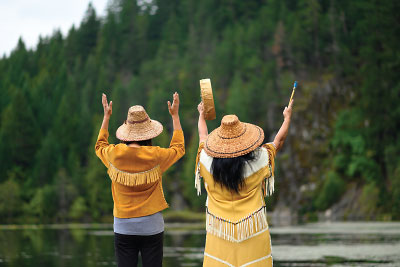Although lack of access to mental health care is a national problem not exclusive to Native populations, Native Americans experience higher rates of comorbid physical and mental conditions than the general population.
Writing in Social Work, David R. Hodge, Ph.D., and colleagues contend that, rooted in Western worldviews, common therapeutic practices are inconsistent with Native American cultural values that center the role of spirituality in well-being and health. Nonetheless, the mindfulness methods rapidly gaining traction in the West have parallels to the practices many Indigenous people have developed and taken part in since time immemorial.
Ongoing efforts to meet these communities’ cultural preferences and needs with a focus on nurtured empowerment are central to the successful implementation of mindfulness and mind-body medicine programs. When explored as potentially congruent with Native American practices and spirituality, mindfulness-based practices may be more readily integrated as a component of mental health treatment than a sole focus on psychotropic medications, which are viewed with distrust in many Native communities. For example, among Native groups across North America, mindfulness is at the core of traditional spiritual practices and community events to nurture a shared intention and to ensure the outcome is completed in the best way: Ceremonies and community events begin mindfully, are carried out mindfully, and end mindfully. Another example of mindfulness practice in this context is that of tending: During a traditional ceremony, participants may attend to water, the earth, animals, plants, fire, and food, as well as to fellow community members sharing in the experience.
In addition, Native American ceremonies and traditional practices generally include ritualized components that teach and promote regulation. In a 2018 brief from the U.S. Administration for Children and Families (OPRE Brief No. 2018-64), Monica Tsethlikai and colleagues note that “self-regulation might need to be more clearly defined as a relational process to better fit the collective … focus of many indigenous cultures, in which individual existence is understood as inseparable from social groups such as family and community.” Further, they describe how, in many Native communities, verbal directions and corrections are de-emphasized in favor of observing and modeling behaviors to reinforce regulation, balance, and mindfulness. Through observing and taking part in ceremonies, Native people practice being fully present, since a successful outcome for the group necessitates that each member participate authentically and in the present moment.
In a 2015 article in the Journal of Child and Family Studies, Thao Le, Ph.D., and Judith Gobert draw three parallels between mindfulness and traditional Native American practices and ways of being. First, they contend that the values of virtue, righteousness, and balance that are emphasized in cultural practices across many different Indigenous communities are in alignment with the core components of mindfulness, which include acceptance, equanimity, kindness, and compassion.
A focus on awareness and interconnectedness is the second parallel between mindfulness and Native American traditions. Le and Gobert, who describe vision quests, sweat lodges, sacred ceremonies, and dances as among the Native American practices meant to draw connections with the land, ancestors, and nature through present moment awareness. Again, many evidence-based meditation and mindfulness practices share this focus on present moment awareness.
The third parallel is silence. In mindfulness, practitioners often focus their attention on a single object, such as their breath, to help silence the rest of the world and make space for new understandings. Le and Gobert note the similarities to Indigenous practices that focus on cultivating silence and listening deeply.
To date, more than 125 randomized clinical trials have shown mindfulness to be effective in treating multiple physical and mental conditions across numerous cultures. For example, in a 2011 publication in the International Journal of Stress Management, Julie Staples, M.D., and colleagues share the outcomes of a 10-session mind-body skills training for Gazan Palestinians experiencing posttraumatic stress disorder. Following the training, participants reported significant relief from symptoms of depression, anxiety, and PTSD and improvements in physical health and social relationships, improvements that were maintained at the 10-month follow-up. These results indicate mindfulness practices not only empower communities to take ownership of their own health but also show flexibility in regard to varying cultural and communal needs. Although not yet formally studied in Native American communities, these findings in other collectivist-minded communities hold promise.
Given the similarities between mindfulness-based practices and the traditional practices valued by Native American communities, as well as the evidence of its utility in supporting people experiencing mental health challenges, there is potential for it to assist in bridging gaps in psychiatric care as experienced by many Native Americans. The connections between traditional healing practices and mindfulness-based medicine may support Native people in reclaiming greater agency and well-being, rather than simply receiving directives from medical professionals. These connections could also further encourage interest and participation in tribal healing practices that may be available through their Native communities.
In implementing mindfulness in a Native American context the input and autonomy of the respective tribal nations and their assessment of their communities’ needs is foremost. This may mean meeting with stakeholders in the community, strengthening mutual trust, practicing respectful listening, seeking feedback, and adapting terms and practices to the specific community.
Time and commitment are needed to develop effective partnerships. In the authors’ experience, the described approach in this article holds promise when working together in support of the health of Native communities. Developing and implementing culturally specific mindfulness programs may be particularly challenging in urban settings where a clinical practice or other service-providing agency may routinely serve Native Americans from a variety of tribal nations, each with unique beliefs and goals as to what constitutes mental health and culturally acceptable care. Nevertheless, we believe that the work is worth undertaking as a necessary and meaningful way of extending the symbolism of land acknowledgment in ways that reflect and reinforce the cultural values and traditions of Indigenous people. ■

